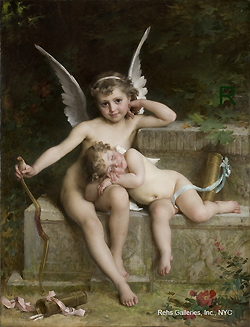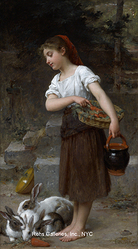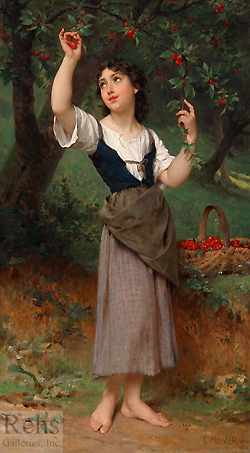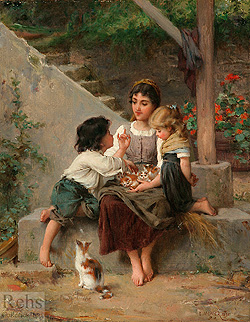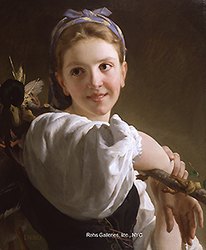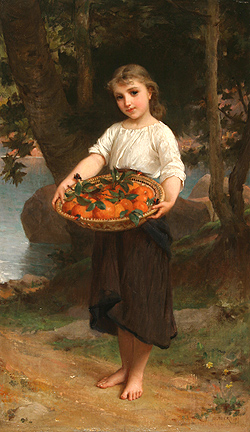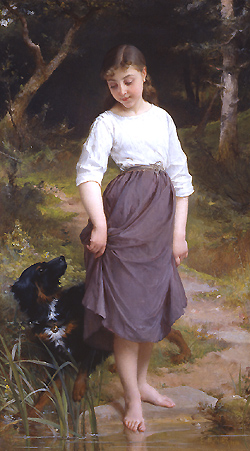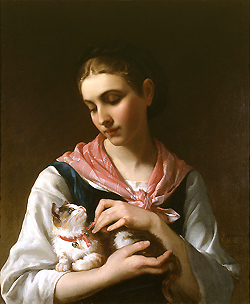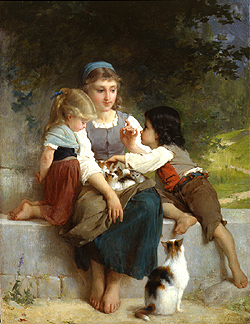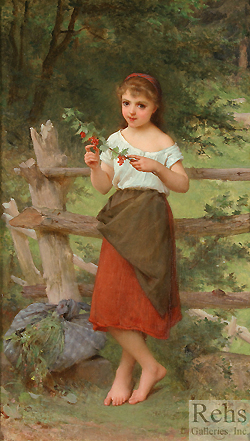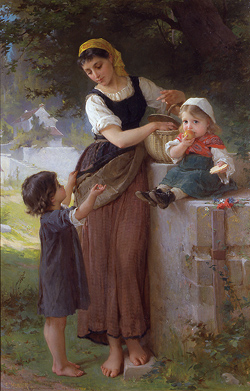BIOGRAPHY - Emile Munier (1840 - 1895)
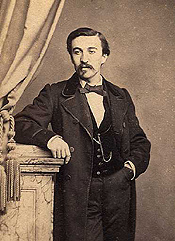
Emile Munier was born in Paris on June 2, 1840, and lived with his family at 66 rue des Fossés, St. Marcel. His father, Pierre François Munier, was an artist upholsterer at the Manufacture Nationale des Gobelins. His mother, Marie Louise Carpentier, was a polisher in a cashmere cloth mill.
Emile and his older brother François attended the communal school. By the time of the birth of his younger brother, Florimond, the family’s situation had improved, with Florimond enrolling at a boarding school. All three brothers were gifted in the art of drawing, each having produced a pastel self-portrait between the ages of 13 and 14. Emile’s is dated 1854.
All three Munier children entered the Gobelins. However, François was the only one who stayed. He, like his father, eventually rose to the position of head foreman. Emile attended drawing, painting, anatomy, perspective, and chemistry classes. This was all in relation to wool dyeing so that he may become an artist upholsterer. The artist Abel Lucas supervised the drawing courses; Mr. Chabale taught the flowers and ornaments classes; Mr. Chevreuil taught chemistry; and Mr. Decaux was the engineer of Arts et Manufactures.
Emile developed a close relationship with his professor, Abel Lucas, and his family. On August 10, 1861, Emile Munier married Henriette Lucas, Abel's daughter, in the chapel of the Gobelins. Emile, then an artist upholsterer at the Manufacture Nationale des Gobelins, continued to draw and paint beside his father-in-law. He studied painting in the Academic tradition, principally by interpreting the works of Boucher.
During the 1860s, Emile received three medals at the Beaux-Arts, and, in 1869, he exhibited at the Salon. Munier became a great supporter of the Academic ideals. He became a follower of William-Adolphe Bouguereau (1825 - 1905), whose subject matter would greatly inspire the young Emile.
In 1867, Henriette gave birth to a son, Emile Henri. Six weeks after the birth, she contracted severe rheumatism and died. In 1871, Munier abandoned his career as an upholsterer and devoted his time solely to painting. He also began teaching classes to adults three nights a week.
Sargine Augrand, a student of Abel Lucas and a close friend of Emile & Henriette (before she died), caught Emile’s eye. Sargine was teaching drawing and had acquired a reputation as a pastel portraitist. She exhibited at the Salon from 1863 to 1870. The young couple decided to marry, with the wedding taking place in Paris on January 4, 1872. The couple lived at 8 rue des Beaux-Arts in a small apartment and studio, where Jean-Baptiste-Camille Corot (1796 - 1875) and Henri Fantin-Latour (1836 - 1904) also had studios.
Emile Munier frequented Bouguereau's studio, to whom he was well-liked and appreciated. The master had even nicknamed him la sagesse (wisdom) or le sage Munier (Munier the wise). In 1873, Emile painted Le Voleur de Pommes and La Leçon de Tricot. In 1874, Sargine Munier gave birth to a daughter, Marie Louise.

Beginning in 1876, the Muniers spent their summer vacations on the Normandy seacoast. There, Emile produced numerous drawings and some watercolors depicting scenes of boats and fishermen. Before joining his family for their summer vacation in 1879, he traveled to the Ardennes to paint a commissioned portrait of Madame de Chanzy. During this trip, he discovered l'École de Nancy (the School of Nancy) and became acquainted with Emile Gallé, with whom he would later collaborate.
His children, Henri and Marie Louise (14 and 7 years old, respectively), were his principal inspirations at the beginning of the 1880s. He continued painting sentimental genre paintings until the end of his life. Marie-Louise is most probably the subject of Naughty boy (1880), L'enfant et le pantin (1880) and La jeune fille et la poupée (1882).
In 1883, the Muniers visited le lac du Bourget (Bourget lake) where Emile certainly painted La jeune fille au lac and La petite fille aux oranges. During their stay in Aix, Emile frequently attended Italian opera. After returning to Paris, he continued his accentuated interest in music and singing.
Emile, who had already painted a Virgin Mary crowned with a halo in 1883, produced an infant Jesus, which became the object of a very popular religious image. It remained a classic of first communion images until the middle of the twentieth century.

In 1885, he painted and exhibited Trois Amis (Favourite Pets). This painting, representing a chubby girl playing on her bed with a kitten and a dog, was an extremely successful work, being reproduced in many forms and used for publicity posters by Pears Soap. With this work, Emile asserted himself as one of ‘the’ painters of young children and their pets. It was eventually acquired by an American collector.
Munier developed an exceptional talent for depicting the short-lived expressions and movements of his subjects. He also became interested in scenes of children in country situations. Beginning in 1886, he regularly returned to Auvergne to produce numerous sketches of young peasants among farm animals.
Many of these country scenes were the starting point of several drawings and paintings, including Le jeune chasseur (1888), La basse-cour (1889), La paysanne à la fourche (1889), La journée des confitures (1891), La jeune fille et le panier de cerises (1891), and La fillette au tricot - La lettre d'amour.

In 1886, he went back to the subject of cherubs, which he had already worked with three years earlier in Armistice (Paris Salon, 1883). His painting L'amour désarmé (Love Disarmed) presented to the Salon in 1886 again displays Bouguereau’s influence on Munier. Several American collectors had actually attributed this work to Bouguereau.
Among his many American patrons were Mr. & Mrs. Chapman H. Hyams. They were important collectors of contemporary French paintings during the nineteenth century and favored artists like Henner, Bouguereau, Gerôme, Vinel, and Schreyer. Munier painted their portrait in 1889. It, along with much of their collection, is now in the New Orleans Museum of Art.
At the Salon of 1890, Emile Munier exhibited Anges gardiens: a little girl in bed surrounded by two allegoric angels. In several works, the artist recaptured the girl’s face with her eyes full of emotion. Throughout 1892, Emile Munier painted mythological and religious subjects, including several cupids, a goddess with an arm raised, a praying Virgin Mary, and the famous Mother and Child. He continued teaching painting in Paris and attending l'Atelier de peinture de l'Ecole Polytechnique from 1892 to 1893.
In 1893, he exhibited L'esprit de la chute d'eau at the Paris Salon, a nude nymph who is not unlike Naissance de Vénus by Bouguereau. He also participated in Chicago's World Columbian Exposition, where he received a medal hors concours. He executed a wonderful portrait of his daughter Marie-Louise in 1893, and one of his daughter-in-law, Marguerite Aumont-Munier, in 1894. These two paintings enhanced and even idealized the two young women dear to his heart.

In 1894, Emile Munier produced several works in his well-affirmed style, including one of two cupids entitled Un sauvetage. He also painted a very unusual work Premier prix, in which a dog stands among flowers at a dog show. During his stay at Mont-Dore, he produced a few watercolors that explored the surrounding landscapes and gardens in Auvergne.
In 1895, he painted La jeune fille et le panier de chatons, celebrated his fifty-fifth birthday on June 4th, and was present at the birth of his grandson, Georges, on June 20th. Merely a few days later, he gave his last drawing class and succumbed to congestion cérébrale the next morning. Emile Munier died on Saturday, June 29, 1895, at 9am. He was buried at the Montparnasse cemetery.
| |||||||||||||||||||




